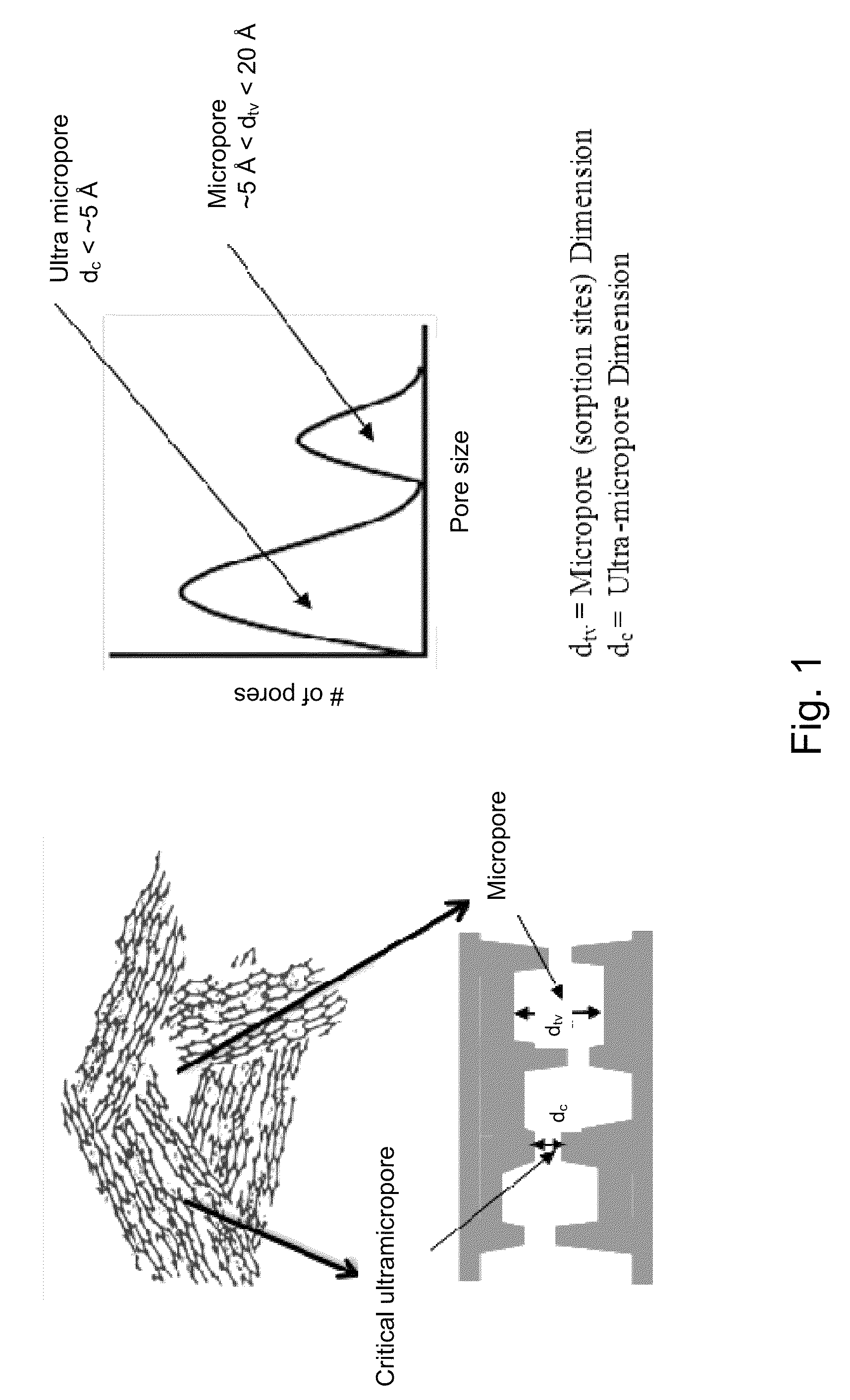Carbon molecular sieve membrane (CMSM) performance tuning by dual temperature secondary oxygen doping (DTSOD)
a technology of secondary oxygen doping and molecular sieve membrane, which is applied in the direction of membranes, oxygen/ozone/oxide/hydroxide, separation processes, etc., can solve the problems of reducing the efficiency of air separation, limiting the improvement of membrane surface area and increasing membrane efficiency, and deeming the use of air separation impractical. , to achieve the effect of high gas selectivity
- Summary
- Abstract
- Description
- Claims
- Application Information
AI Technical Summary
Benefits of technology
Problems solved by technology
Method used
Image
Examples
example 1
Materials and Preparation of Hollow Fiber Polymer Precursor Membranes
[0072]A polyimide precursor, 6FDA / BPDA-DAM (1:1) (FIG. 3), was used in this work to prepare asymmetric hollow fiber membranes by a dry-jet / wet-quench spinning process (FIG. 4). 6FDA / BPDA-DAM, polymer was first dried in a vacuum oven at 110° C. overnight to remove moisture. The 6FDA / BPDA-DAM precursor material discussed herein is completely amorphous based on extensive prior characterization. A spinning dope was then prepared with a composition of 20 wt % 6FDA / BPDA-DAM, 47.5 wt % 1-Methyl-2-pyrrolidinone (NMP, Sigma-Aldrich Inc., 99.5%), 16 wt % Ethanol (Sigma-Aldrich Inc., ≧99.5%), 10 wt % Tetrahydrofuran (THF, Sigma-Aldrich Inc., 99.5%), and 6.5% LiNO3 (Sigma-Aldrich Inc., 99.5%) in a Qorpak® glass jar sealed with a Teflon® cap. The mixture was dissolved by placing the jar on a roller first under heat followed by rolling at room temperature to produce a homogeneous spin dope (usually one week). The prepared dope w...
example 2
[0100]A series of samples were also tested to develop and explore the range of conditions for the process. The procedure for in-situ pyrolysis and heat post treatment involves pyrolysis of polymer membranes under low oxygen atmosphere (either UHP argon or 1 ppm oxygen with balanced argon cylinders) to get the highly permeable CMS membranes with moderate selectivity. These CMS membranes are again heated to a selected high temperature (mainly 550° C.) and exposed to higher oxygen amount (10 or 24 ppm) than used during pyrolysis. This results in a great improvement of selectivity with a little compromise with permeance (table 5 &FIG. 9).
[0101]
TABLE 5Carbon Membrane for O2 / N2PyrolysisSoakAtmosphere forTemperatureSoak6FDA-BPDA-DAMPyrolysisTemperatureTimeHeat Postfor HPTTimeSTATEAtmosphere(°C.)(min)Treatment(°C.)(min)1ST7-POLYMER——————2RS_6F_Sp2_ST7_06162011_550_UHP ArUHP Ar550120———3RS_6F_Sp2_ST8_06212011_550_UHP ArUHP Ar550120———4RS_6F_Sp2_ST7_06263011_500_4hUHP Ar500240———5RS_6F_Sp2_ST...
example 3
[0104]Efforts to test and develop the membranes also required some development for securing the hollow fiber membranes to the apparatus.
[0105]Permeation Test at Elevated Temperature.
[0106]Epoxy leakage was a challenge faced during experiments at high temperature. For the testing at 35° C. normally 5 min epoxy (Scotch-Weld epoxy adhesive, 3-5 min curing) is used, which works well at this temperature. Due to limitation of working temperature to 60° C. with 5 minute, high temperature epoxies were used to seal the ends. In the following section details are given regarding high temperature epoxies used in the present study:
[0107]a. DURALCO 4525 epoxy (500 F)
[0108]b. STYCAST (Emerson and Cuming STYCAST 2651-40)
[0109]Initially, it seemed that these epoxies were working well for the study at high temperature, however, repeated observation of very low selectivity at higher temperatures made us to suspect leakage at the epoxy-fiber interface. To explore this issue, we proposed the epoxy-wire ...
PUM
| Property | Measurement | Unit |
|---|---|---|
| temperature | aaaaa | aaaaa |
| temperature | aaaaa | aaaaa |
| temperature | aaaaa | aaaaa |
Abstract
Description
Claims
Application Information
 Login to View More
Login to View More - R&D
- Intellectual Property
- Life Sciences
- Materials
- Tech Scout
- Unparalleled Data Quality
- Higher Quality Content
- 60% Fewer Hallucinations
Browse by: Latest US Patents, China's latest patents, Technical Efficacy Thesaurus, Application Domain, Technology Topic, Popular Technical Reports.
© 2025 PatSnap. All rights reserved.Legal|Privacy policy|Modern Slavery Act Transparency Statement|Sitemap|About US| Contact US: help@patsnap.com



